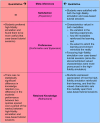High-fidelity simulation versus case-based tutorial sessions for teaching pharmacology: Convergent mixed methods research investigating undergraduate medical students' performance and perception
- PMID: 39150900
- PMCID: PMC11329139
- DOI: 10.1371/journal.pone.0302609
High-fidelity simulation versus case-based tutorial sessions for teaching pharmacology: Convergent mixed methods research investigating undergraduate medical students' performance and perception
Abstract
Introduction: Medical educators strive to improve their curricula to enhance the student learning experience. The use of high-fidelity simulation within basic and clinical medical science subjects has been one of these initiatives. However, there is paucity of evidence on using simulation for teaching pharmacology, especially in the Middle East and North Africa region, and the effectiveness of this teaching modality, relative to more traditional ones, have not been sufficiently investigated. Accordingly, this study compares the effects of high-fidelity simulation, which is designed in alignment with adult and experiential learning theories, and traditional case-based tutorial sessions on the performance and perception of undergraduate Year 2 medical students in pharmacology in Dubai, United Arab Emirates.
Methods: This study employed a convergent mixed methods approach. Forty-nine medical students were randomly assigned to one of two groups during the 16-week pharmacology course. Each group underwent one session delivered via high-fidelity simulation and another via a case-based tutorial. A short multiple-choice question quiz was administered twice (immediately upon completion of the respective sessions and 5 weeks afterwards) to assess knowledge retention. Furthermore, to explore the students' perceptions regarding the two modes of learning delivery (independently and in relation to each other), an evaluation survey was administered following the delivery of each session. Thereafter, the iterative joint display analysis was used to develop a holistic understanding of the effect of high-fidelity simulation in comparison to traditional case-based tutorial sessions on pharmacology learning in the context of the study.
Results: There was no statistically significant difference in students' knowledge retention between high-fidelity simulation and case-based tutorial sessions. Yet, students expressed a greater preference for high-fidelity simulation, describing the corresponding sessions as more varied, better at reinforcing learning, and closer to reality. As such, the meta-inferences led to expansion of the overall understanding around students' satisfaction, to both confirmation and expansion of the systemic viewpoint around students' preferences, and lastly to refinement in relation to the perspective around retained knowledge.
Conclusion: High-fidelity simulation was found to be as effective as case-based tutorial sessions in terms of students' retention of knowledge. Nonetheless, students demonstrated a greater preference for high-fidelity simulation. The study advocates caution in adapting high-fidelity simulation, where careful appraisal can lend itself to identifying contexts where it is most effective.
Copyright: © 2024 Kaddoura et al. This is an open access article distributed under the terms of the Creative Commons Attribution License, which permits unrestricted use, distribution, and reproduction in any medium, provided the original author and source are credited.
Conflict of interest statement
The authors have declared that no competing interests exist.
Figures






Similar articles
-
Investigating the learning value of early clinical exposure among undergraduate medical students in Dubai: a convergent mixed methods study.BMC Med Educ. 2025 Apr 30;25(1):638. doi: 10.1186/s12909-025-07212-9. BMC Med Educ. 2025. PMID: 40307797 Free PMC article.
-
Effects of building resilience skills among undergraduate medical students in a multi-cultural, multi-ethnic setting in the United Arab Emirates: A convergent mixed methods study.PLoS One. 2025 Feb 27;20(2):e0308774. doi: 10.1371/journal.pone.0308774. eCollection 2025. PLoS One. 2025. PMID: 40014577 Free PMC article.
-
Development of active learning modules in pharmacology for small group teaching.Educ Health (Abingdon). 2015 Jan-Apr;28(1):46-51. doi: 10.4103/1357-6283.161851. Educ Health (Abingdon). 2015. PMID: 26261114 Clinical Trial.
-
Evaluation of problem-based learning for pharmacology based on a comprehensive analysis in undergraduate students.Medicine (Baltimore). 2024 Oct 11;103(41):e39376. doi: 10.1097/MD.0000000000039376. Medicine (Baltimore). 2024. PMID: 39465835 Free PMC article.
-
Effectiveness of high fidelity simulation versus low fidelity simulation on practical/clinical skill development in pre-registration physiotherapy students: a systematic review.JBI Database System Rev Implement Rep. 2019 Jun;17(6):1229-1255. doi: 10.11124/JBISRIR-2017-003931. JBI Database System Rev Implement Rep. 2019. PMID: 30964770
Cited by
-
Self-medication among university students in Guangdong province, China: a cross-sectional study using the KAP model.Front Public Health. 2025 Jul 14;13:1601731. doi: 10.3389/fpubh.2025.1601731. eCollection 2025. Front Public Health. 2025. PMID: 40726944 Free PMC article.
-
Investigating the learning value of early clinical exposure among undergraduate medical students in Dubai: a convergent mixed methods study.BMC Med Educ. 2025 Apr 30;25(1):638. doi: 10.1186/s12909-025-07212-9. BMC Med Educ. 2025. PMID: 40307797 Free PMC article.
-
Effects of building resilience skills among undergraduate medical students in a multi-cultural, multi-ethnic setting in the United Arab Emirates: A convergent mixed methods study.PLoS One. 2025 Feb 27;20(2):e0308774. doi: 10.1371/journal.pone.0308774. eCollection 2025. PLoS One. 2025. PMID: 40014577 Free PMC article.
-
Medical students' perception of assessment and its effects on their learning in Dubai: a convergent mixed methods study.Front Med (Lausanne). 2025 Aug 4;12:1620437. doi: 10.3389/fmed.2025.1620437. eCollection 2025. Front Med (Lausanne). 2025. PMID: 40832098 Free PMC article.
References
MeSH terms
LinkOut - more resources
Full Text Sources
Research Materials

